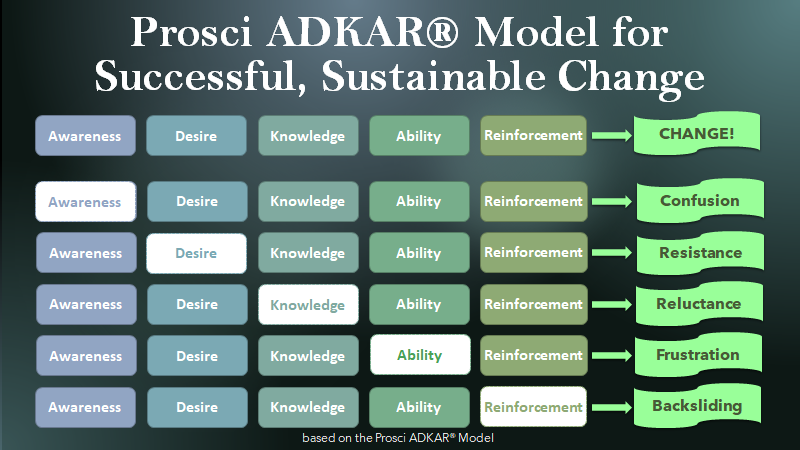Being an Exemplar
This week’s Insights were inspired by a visionary leader who is embarking on an ambitious organizational transformation with the goal to become an exemplar in rural healthcare delivery. We were discussing the challenges and excitement of leading an organization through change, transition, and transformation. I share some of those insights here with you as you lead your organizations and teams to new heights.
Creating a Vision
When an organization comes together to create a vision for the future, there is energy in the room. In the days following, casual conversations start to take place. Participants who felt energized by the opportunity to contribute begin talking with others about the experience. Human nature, for some, to share their excitement about where things are headed.
There will also be those who participated in shaping the vision and plan, but who are now in a wait and see mode. They liked what they heard (and contributed) but they don’t want to share too much with others because they aren’t confident that the organization can truly “pull this off.” This is also human nature in a transformation. These individuals don’t want to actively get others on-board just yet until they see more “evidence” that this is doable and not just a (lofty) dream.
Resistance to Change
There will also be those resistant to “the change.” They subtly (or not so subtly) will resist the change and particularly the aspects that require them to change something themselves. This too is human nature.
Usually and roughly, one third “early adopters,” another third “fence sitters,” and a third “resistant” (but not all of that last third visually showing it; some are quite good at keeping under the radar initially with their resistance).
A skillful change agent understands and anticipates this human nature in any change effort, big or small. And so, their work begins very early on — providing information and support – creating the case for change. Vividly painting a picture of the future and illuminating why we can’t maintain the status quo any longer. Listening carefully to questions and concerns, seeking to understand what the benefits of the change will be to individuals within the organization and to the customers these individuals serve. Tuning in with an ear to the ground in order to have a thoughtful conversation with an individual who is skeptical or not in support of the change.
Sometimes pleasant surprises arise early on in an organizational transformation that can serve as fuel for the lift off:
- People who are so tired of the past and even frustrated with the present that they are glad to know that things will change (whatever that change is), because “it just has to be better than what is.”
- Formal and informal leaders who have created a powerful combination of change ingredients (the burning platform of why we can’t maintain the status quo along with the beginnings of a picture of a future where things will be better.
- Enthusiastic individuals who come forward wishing to contribute and be involved.
In spite of early successes, managing change & transitions is ongoing and a significant part of any organizational transformation whether that transformation is by choice or by necessity. Making change “stick” will have many waves during any major organizational transformation.
The resistors (the overt ones and those carefully flying under the radar at this point) will be more than happy to “recruit” others and they likely already are! They are seeking allies. That is what this third does early on in a change effort. They try to build a coalition.
So, I tend to use more of a subtle draw forward that appeals to the enthusiastic early adopters, while giving ideas to the fence sitters to come to “this side of the fence.” I know that if I force them to get off the “wait and see fence” before they are ready, they may choose the other side. I am content to let them watch and wait while simultaneously providing them with clarifying information they need or seek. Letting them accumulate the necessary facts and emotions so that they eventually feel that they can get off the fence; no longer feeling the need to watch and wait.
Leading the Transformation
At each step in an organizational transformation, we as leaders, advisors, and change agents are carefully and thoughtfully considering what individuals need to join the transformation journey. Designing each phase and carefully crafting each communication (whether an email, presentation, or story), paying attention to both our tone and message, thoughtfully offering questions for contemplation and inspiration.
Organizations change because individuals change. And adept change agents help individuals move through the transitions.
As William Bridges said: “It isn’t the changes that do you in, it’s the transitions. Change is not the same as transition. Change is situational: the new site, the new boss, the new team roles, the new policy. Transition is the psychological process people go through to come to terms with the new situation. Change is external, transition is internal.”
My colleague and associate, Christian Milaster, echoes the ADKAR model when he says:
- If people are CONFUSED it’s because they are not yet fully AWARE
- If people are RESISTANT it’s because they do not yet have the DESIRE
- If people are RELUCTANT it’s because they don’t KNOW how to go about it
- If people are FRUSTRATED it’s because they don’t have the ABILITY to do it
- If people are BACKSLIDING into hold habits, it’s because there is inadequate REINFORCEMENT

When we understand the nature of change, transition, and transformation, we can expertly guide our teams and our organizations to achieve aspirational visions. We can seek out partners who will bolster our efforts.

If you’d like to receive these Inspirations in your inbox every other week, you can subscribe to Kathy’s Excellence Advantage Inspirations Newsletter.
Kathy Letendre, President and Founder of Letendre & Associates, advises organizations and leaders to create their excellence advantage.
Contact Kathy by phone or text at 802-779-4315 or via email.

